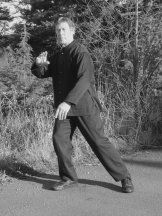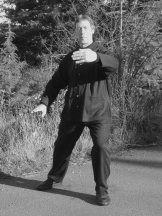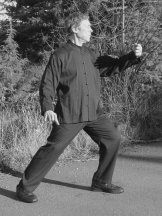Introduction To Breaking Down The Movements
This is the heart of the on-line course. It will be the most important part for students, as a majority is very concerned with getting the movements correct as soon as possible. When the movement is correct, the energy will flow more smoothly and the mind can relax. So pay close attention to how you are doing each movement. Take responsibility for your learning and progress. Practice diligently. You will be rewarded with a feeling of satisfaction that you are doing your best, as well as gaining a life skill.
Intention is the Master Key to the highest levels of Tai Chi practice. Intention leads and directs energy. For that reason, it is important to know what you want to accomplish in each movement of the form. I give one practical application for each movement so you can start to work with your intention. Each movement may have dozens of possible applications. Each would result in a slightly different pattern of internal energy. Don’t be too concerned if the application I demonstrate is different than one you might already know. What is important is to have something in mind so you can practice on making that practical movement easy, relaxed, and natural.
I will make reference to an opponent in explaining the practical aspects of each movement. I could also use the term partner because in class we always use a partner to work on our understanding of the movements. Most students are not interested in studying Tai Chi for fighting and might object on the term opponent, yet for many reasons I will retain use of that term.
Important — Each movement starts where the previous movement ended. For example, if you want to know the beginning hand and foot positions for Snake Creeps Down, you would first look to the ending positions for Single Whip. This is true for all the movements in this course.
The beginning direction is referred to as north (even though this might not be true), and all directions relate to this beginning direction.
#1 Commencement of Tai Chi Chuan
The beginning is the seed of all that is to follow. It sets the mood, the pace, and the level of knees from the floor. You are moving from nothing (Wu Chi) to something (Tai Chi). It is a simple movement; yet do not take it too lightly.
 Starting from Wu Chi Stance. Feel your feet firmly on the ground. Let yourself relax (Sung – meaning relax with a sense of inner firmness, like a tire inflated with air). Concentrate on your lower Dan Tien (slightly below your belly button), and let your breath be directed to this area. Turn the palms to face the rear and let the elbows soften. Feel a sensation in the center of the palms, as if there was something behind your palms trying to push them forward and you are not letting that happen. When you feel this sensation, you are ready to begin.
Starting from Wu Chi Stance. Feel your feet firmly on the ground. Let yourself relax (Sung – meaning relax with a sense of inner firmness, like a tire inflated with air). Concentrate on your lower Dan Tien (slightly below your belly button), and let your breath be directed to this area. Turn the palms to face the rear and let the elbows soften. Feel a sensation in the center of the palms, as if there was something behind your palms trying to push them forward and you are not letting that happen. When you feel this sensation, you are ready to begin.

 Inhale and allow the two arms to rise up to the level of the chest. It is as if the wrists were being pulled up by a string from above. Keep the hands relaxed. Keep the elbows drooping or pointing downward. Do not raise the shoulders. Concentrate on the wrists.
Inhale and allow the two arms to rise up to the level of the chest. It is as if the wrists were being pulled up by a string from above. Keep the hands relaxed. Keep the elbows drooping or pointing downward. Do not raise the shoulders. Concentrate on the wrists.

 Let the elbows start to sink as if there were weights attached to the bottom of the elbows. As this happens, the hands fill, the fingers extend with energy. Keep the elbows in front of the body. We never let the elbows get behind the body. The hands end up parallel to the ground. Concentrate on the elbows sinking.
Let the elbows start to sink as if there were weights attached to the bottom of the elbows. As this happens, the hands fill, the fingers extend with energy. Keep the elbows in front of the body. We never let the elbows get behind the body. The hands end up parallel to the ground. Concentrate on the elbows sinking.

 The two hands press down until they reach the level of the lower Dan Tien. The feeling is as if you were trying to push a log under water – equal pressure on the bottom of the palms. When the hands reach the lower Dan Tien, squat down until the knees just cover the toes. Make sure the knees go in the direction of the toes. Keep the spine straight. Concentrate on the base of the spine pushing downward and the top of the head pushing upward.
The two hands press down until they reach the level of the lower Dan Tien. The feeling is as if you were trying to push a log under water – equal pressure on the bottom of the palms. When the hands reach the lower Dan Tien, squat down until the knees just cover the toes. Make sure the knees go in the direction of the toes. Keep the spine straight. Concentrate on the base of the spine pushing downward and the top of the head pushing upward.
 Finally, allow the palms to return to the staring position with the palms facing backward, elbows soft.
Finally, allow the palms to return to the staring position with the palms facing backward, elbows soft.
The idea of Commencement is to open the body to the universal energy by inhaling and raising the arms, draw the energy into the core by sinking the elbows, concentrate this energy in our lower Dan Tien (energy reservoir) by pressing the hands downward, and finally splitting the energy into jing chi (heavy energy that sinks) and shen chi (light energy that rises). We are now stable on the bottom and light on the top, ready to deal with whatever happens next.
#2 – Ward Off Left
This movement introduces the essential energy of Peng. Peng is one of the eight energies (the rest will be discussed when they arise), and I would say, the most important. Peng is energy that expands upward and outward. It is the energy that inflates the inside of the body to keep the structure upright and firm. It could be compared to the air inside a tire. It gives support without being hard and stiff.
Practical Application: The opponent attacks with her right hand. I join with her incoming energy and neutralize it to the right. Since opponent’s attack failed, she tries to retreat. I block her retreat with my left foot, and as she moves backward, I add Peng energy with the back of my left forearm. She is thrown over my left leg.

 Shift the weight to the left and turn the body slightly to the right. As you do this, turn out the right toe to face 45* right of north. Be sure to open the leg by rotating the hip, keeping the leg straight. The right hand swings up to the middle of the chest with the fingers facing forward (north). Keep the elbow relaxed and sinking.
Shift the weight to the left and turn the body slightly to the right. As you do this, turn out the right toe to face 45* right of north. Be sure to open the leg by rotating the hip, keeping the leg straight. The right hand swings up to the middle of the chest with the fingers facing forward (north). Keep the elbow relaxed and sinking.
The body turns slightly to get out of the way of the strike. The right hand comes up to join with the incoming force. The toe turns out to enable you to move in that direction. You could kick with the right foot or quickly root on to it.

 Shift the weight onto the right foot. Roll up the left heel. As you do this, the right hand turns to face down and remains in the center of the chest area. The left arm moves to the center of the body, hanging downward.
Shift the weight onto the right foot. Roll up the left heel. As you do this, the right hand turns to face down and remains in the center of the chest area. The left arm moves to the center of the body, hanging downward.
The weight shifts in order to join and follow opponent’s energy. The right palm turns down in order to pull. The left arm moves center to block possible attack to lower body. The left foot is ready to step or kick, yet has some root. You are ready for many possible reactions from opponent.

 Step ahead with the left foot, touching and rooting with the left heel. Be sure not to move the body when stepping. Also, be careful not to narrow the stance when placing the foot down. The rest of the body stays basically the same.
Step ahead with the left foot, touching and rooting with the left heel. Be sure not to move the body when stepping. Also, be careful not to narrow the stance when placing the foot down. The rest of the body stays basically the same.
The opponent realizes that she is in trouble as her attack was neutralized. In fact, I added a little pull with my right hand to upset her balance. With my Ting Jin (listening energy) I realize she is going to retreat so I step forward with my left foot to block or follow her retreat. My weight is still on my right foot so I can sweep, kick, or retreat myself.

 Shift the weight to the left foot and as you do, turn the waist until the nose points to the left knee. The left arm rises up to end up in the center of the chest with the palm facing the chest. The right hand moves down to the right side of the body with the fingers facing to the right. There is a strong connection between the two arms as they separate. It is like pulling a rubber band apart.
Shift the weight to the left foot and as you do, turn the waist until the nose points to the left knee. The left arm rises up to end up in the center of the chest with the palm facing the chest. The right hand moves down to the right side of the body with the fingers facing to the right. There is a strong connection between the two arms as they separate. It is like pulling a rubber band apart.
As partner retreats, I Peng forward, adding unexpected energy to her backward energy. Because my leg is behind her, and I am holding onto her right arm, she cannot safely move and maintain balance.
 Ward Off Left is the perfect example of the Tai Chi Chuan principle of “overcoming the force of a thousand pounds with an ounce”. If I wanted to throw my opponent away and she was in a rooted position, I would have to use force. By joining, listening, and following her energy I can add a very small amount of force and upset her balance.
Ward Off Left is the perfect example of the Tai Chi Chuan principle of “overcoming the force of a thousand pounds with an ounce”. If I wanted to throw my opponent away and she was in a rooted position, I would have to use force. By joining, listening, and following her energy I can add a very small amount of force and upset her balance.
In the art of Tai Chi, we seek to do the greatest amount of work with the least effort. A little pull at the correct moment may result in partner being placed in a very uncomfortable position.
This movement also clearly illustrates the principle of Duei La or opposition of internal force. When the left foot steps forward, more energy is sent down to the sole of the right foot. When the left arm is expanded up and out to the front, the right arm is pulled to the rear to balance. As the body moves forward onto the left foot, energy is moving backward in the low back. Yin and Yang are always balanced.
<<Back to index
